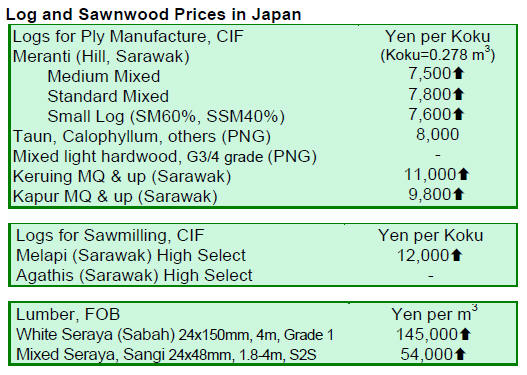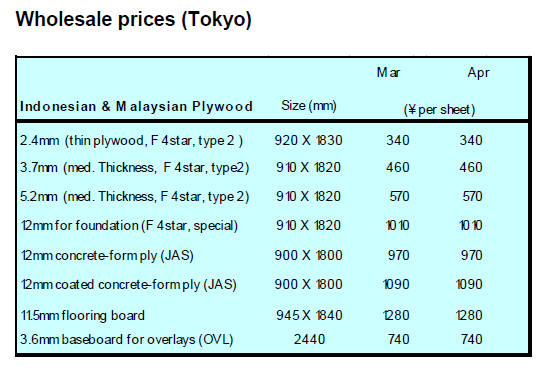Japan Wood Products
Prices
Dollar Exchange Rates of
28th Apr 2011
Japan Yen 81.54
Reports From Japan
Timber industry in crisis
Many domestic wood processing mills in coastal areas in
eastern Japan suffered extensive damage caused by the
March 11 earthquake and tsunami. It is estimated that a
capacity of 60,000 cu.m of plywood per month has been
lost.
Damaged infrastructure and a shortage of fuel brought all
businesses in the region to a halt. As a result, the supply of
plywood in the major markets of Tokyo and Osaka was
badly affected. Other unaffected sawnwood and plywood
mills have plans to increase production to supply wood
materials for restoration work, but they are also suffering
from periodic electricity blackouts.
Ports in Hachinohe, Sendai, Sohma, Onahama and
Hitachinaka are closed and shipments being are diverted to
Tokyo and Kawasaki. Tokyo Lumber Terminal has
secured 49,000 square metres of land as an emergency
storage area reports the Japan Lumber Report (JLR).
The Japanese Ministry of Land, Infrastructure and
Transport disclosed that some 4,702 buildings were totally
destroyed and 2,496 units half destroyed. In addition,
1,150 units are unsafe with a high risk of collapse.
Tropical plywood processing after quake
The earthquake and tsunami caused devastating damage to
Ofunato Plywood mill which processed tropical hardwood
logs from Southeast Asia. Other tropical plywood
manufacturers experienced only little damage such as
collapsed log and plywood piles. Plywood manufacturers
are now trying to boost production which may push log
prices up, reportsthe JLR.
Japan’s plywood market slowly getting back to normal
The JLR is reporting that the confusion in the plywood
market immediately after the East Japan earthquake in
March is now easing and that trade is slowly getting back
to normal.
There was a period of panic buying of plywood by
companies building house for delivery at the end of March
but this is over now. There was also a period of aggressive
purchases of imported plywood in the weeks after the
earthquake and tsunami as many plywood producers in the
quake hit area suffered damage.
This very active sourcing pushed up prices but now buyers
are cautious and are not chasing high priced plywood.
The market for imported plywood during March was
chaotic with prices soaring but by April demand had
cooled down. Concrete formboard JAS 3x6 panel prices
were Yen 1,200 per sheet delivered, Yen 210-240 higher
than early March prices.
Coated concrete formboard 3x6 panel was priced at about
Yen 1,300, Yen200-230 up. Structural 12mm 3x6 panel
(F 4star) is selling at around Yen 1,300 Yen280 up and
firming. Imported thin panel of 2.4mm (type 2/F4star) is
currently at around Yen380-400, Yen40-60 up.
The supply of imported 4mm thin panel is currently
extremely tight according to the JLR.
Log supply still a problem in Sabah and Sarawak
While the rain season is over in Sabah and Sarawak
producers are saying that the weather continues to be
unsettled and that this is hampering logging.
This is at a time when export demand in India and Taiwan
P.o.C is strong. Malaysian plywood producers are
feverishly sourcing logs. The JLR reports that Indian
buyers are apparently tiring of the spiralling log prices in
Sarawak and have started looking in Papua New Guinea
for alternative species.
April FOB prices reported by the JLR indicate that
Sarawak meranti regular log prices have increased to
US$350 per cu.m and that Japanese buyers are expecting
another round of increases. Small meranti log prices are
said to be around US$330 per cu.m while super small logs
are priced at US$315 per cu.m.
In 2010 the top buyer of Sarawak logs was India which
imported some 2.2mi cu.m. China was second largest
buyer taking 588,000 cu.m followed by Taiwan P.o.C with
477,000 cu. Japan was forth largest importer of Sarawak
logs taking 370,000 cu.m.
In Japan, Sarawak meranti regular log prices in April were
Yen 8,000-8,200 per koku CIF, Yen400-500 up form
January. Some plywood mills have reportedly reduced
purchases of high priced tropical logs and are increase the
production of softwood plywood.
Tsunami devastated Ishinomaki and other coastal
towns
It is now just over a month since the mega-quake in Japan
and now it is possible to get a clearer understanding of the
extent of the damage to the timber sector in the region.
On the coast of Miyagi and Iwate prefecture, there are
many major plywood mills. Around port of Ishonimaki, in
the industrial area, there are three Seihoku plywood mills
as well as particleboard and MDF plant.
These factories are the core of the Seihoku group’s wood
processing capacity. There are also other mills such as the
Ishinomaki Plywood, other sawmills and the Nippon Paper
plant in the affected areas.
The tsunami breached the high sea defences and swamped
the mills pushing plywood stocks into the factories and
manufacturing lines. Apparently logs are scattered
throughout the residential areas and recovery will be a
problem as it is difficult to determine ownership.
Even when the processing lines are restored the problem
of erratic electric power supply will remain.
Power substations have been destroyed and authorities say
it will take 2-3 months for temporary substations to be
established and even then the power available will be less
than before the crisis.


Related News:
|